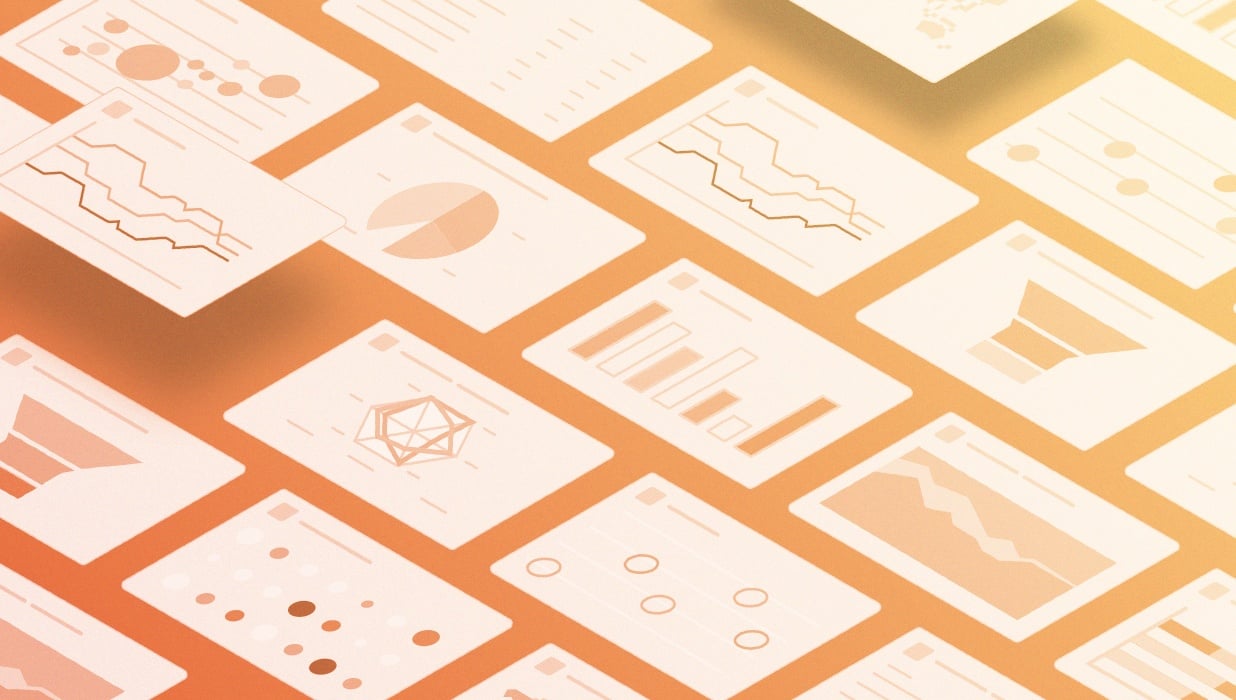
Social networks have been around for quite some time now, however, social media marketing is still in its baby feathers compared to more classic marketing approaches. New tools and concepts are popping up almost every day - or so it sometimes seems at least. Of course all these new possibilities are being discussed vividly on social media blogs and lots of new terms are created by doing so. It’s sometimes hard to keep track of all these social media buzzwords or people, who are new to social media marketing, have to catch up on it. This is why we created this list of important terms that every social media marketer should know.
Analytics
Generally speaking, analytics is about gathering data from the web in order to analyze it and find patterns of behavior. There are different analytics tools out there - both free and paid - that specialize in different aspects. Web analytics tools like Google Analytics track visits to and interactions with websites through a tracking tag within the code of the site. Social media analytics tools fetch quantitative data through the APIs of various social networks and help analyze them. By setting up specific KPIs, goal achievements can be measured.
The illustration below shows how data is collected and aggregated in social media analytics.
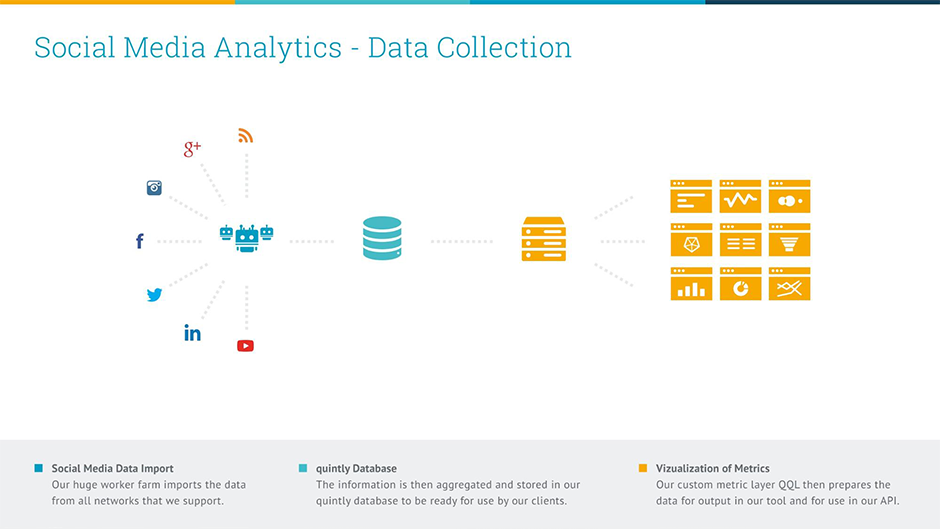
Check out our comprehensive guides on Facebook Analytics, Instagram Analytics and Twitter Analytics to find out how you can set a valuable social media analytics process.
Best time to post on social
Since the rise of social networks, one of the most controversial issues is determining when is the most effective time to post on social media. We at quintly believe there is no rule of thumb. Therefore, the best time to post has numerous factors that need to be taken into consideration. What’s your product? Who is your audience? What is your industry? However, you need to answer a couple of very specific and individual questions in order to find the ideal posting time. That’s why we created the following metric. It shows when a certain profile (that can be yours or a profile of your competition) posts and the interactions it received.
In the example below, you can see at what times Mercedes-Benz posted in one week. The time of posting is represented by the blue circles. The larger the grey circles inside them are, the higher the interaction rate for the post is.
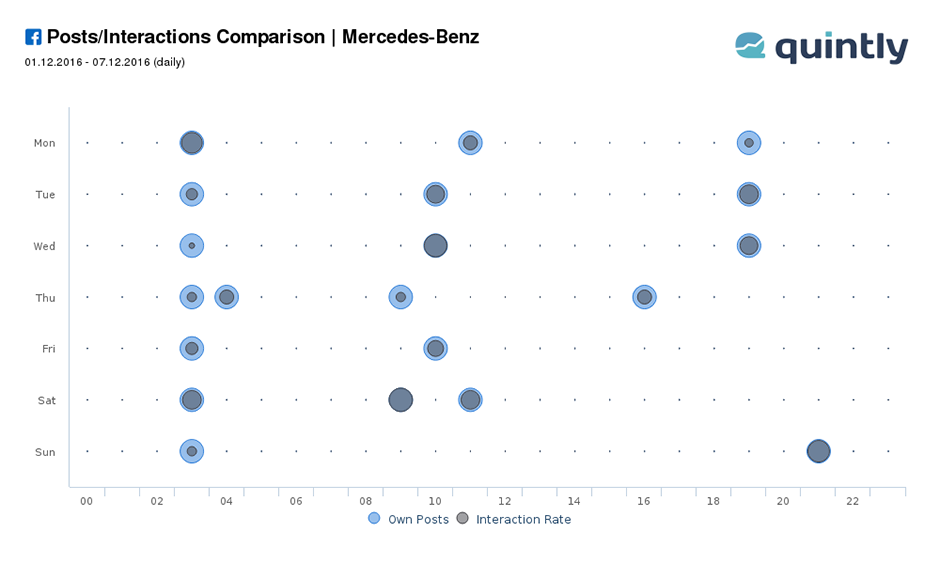
Big Data
Another term for “a huge amount of data”? Big Data! To be a bit more serious: Big Data refers to the act of processing and working with the insights you can draw from the large data pools that are available today.
Business intelligence
This term refers to all applications, processes, technologies and data that enables you to collect, analyze and present information on your business. Business intelligence solutions can provide historical and current data, but it can also predict future developments based on existing data. Based on the insights you can get from business intelligence, you can form well informed decisions and create new strategic business opportunities. Social media analytics can be considered as a part of business intelligence.
Chatbots
Instant messaging has become a huge thing and we send hundreds of messages on our smartphones every week; some of us every day. Because it has become such a central means of communication among people, many users also expect businesses to be available for customer service in messengers like Facebook Messenger or Whatsapp. This is, of course, a lot of work for businesses, so some automation makes sense. This is where chatbots come into play. These little bots can answer questions and give information based on queries in natural written language. It is also possible to place orders with them. Many companies already use chatbots. Among them are Uber, Sephora, KLM and Whole Foods.
Also read: A Social Media Chatbot Can't Beat a High-Quality Customer Service Team
CTR
The CTR - click-through rate - is a term that has been around pretty much since the existence of online ads. It is the number of clicks on a given ad divided by the number of impressions (cross reference impressions here, maybe also with anchor). For example, if an ad gets 1,200 impressions and 100 people click on it, the CTR accounts to 8.33%. CTR is a basic but useful number to help determine the performance of an ad.
Competitive benchmarking
Measuring your own performance online is very important and has been done ever since Google introduced its well-known tool, Google Analytics. On social media channels, marketers trusted their gut feeling for a long time. In the meantime, the majority of successful marketers got increasingly number-driven. In social, you have a great advantage with web analytics, since you are able to compare, relatively easily, your performance with your competition. Through this approach you see what the interactions you received are worth by comparing them to the performance of your competitors. Competitive Benchmarking delivers insights into your competition that can improve your data-driven decision making process significantly.
In the example below, you can see a benchmark between Mercedes-Benz and BMW regarding the average interactions they received per post.
Content marketing
Reportedly the holy grail of marketing, but here is a more precise definition that can be found on the Content Marketing Institute.
Content marketing is a strategic marketing approach focused on creating and distributing valuable, relevant, and consistent content to attract and retain a clearly-defined audience — and, ultimately, to drive profitable customer action.
We at quintly deeply believe in good content that brings values to our clients, partners and readers. That’s why we put a lot of effort into well-researched blog articles and social media studies with huge data sets. For us, content marketing consists of: Blog posts, Ebooks, Webinars, and Videos, which are promoted through our social media channels. Then, we use quintly to measure the interactions and other insightful metrics we were able to achieve.
If you want to become a Social Media Pro - check out our webinar section with latest insights.
Conversions
This term refers to the process of an (interested) visitor on your web page or social media profile becoming a user or client. For example, let’s assume you run a web shop that sells artfully designed laptop cases. When a visitor is on your page and - maybe after his or her third visit - buys a case, this would be counted as one conversion. In this case it means that one buy equals one conversion. In some context, conversion are not always equal with selling your product. You might also count a trial sign up for your software as a conversion.
Dark posts
Posts that are not visible on the timeline of a Facebook page are considered as “dark posts”. These are mainly posts that are set up specifically as an ad, for example with the Facebook ads manager. They are different from “sponsored posts”, which are posts that are visible on the profile’s timeline but boosted through spending money on it after creating them like any regular post.
Engagement
Engagement is often used synonymously with interactions. On Facebook interactions are engagement with a certain post is or can be: Reactions (including the Like and all “New Reactions": Love, Haha, Sad, Wow and Angry), comments and shares. As you cannot share content per default on Instagram, interactions here are Likes and comments. On Twitter, retweets, likes and replies are considered as engagement.
Please note that there are several different definitions of engagement. For example, within quintly, you can measure interactions, but also if users have clicked on your content without triggering one of the mentioned interactions. As this is also some form of engaging with content, our engaged users metric also counts these clicks in and thus contains more than only the interactions listed above.
Also read: 10 Tips and Tricks for Better Interaction on Instagram
Ephemeral data
This term means data that is not stored and is supposed to disappear after viewed. The best example for the use of ephemeral data in social might be Snapchat or Instagram Stories, where content is automatically deleted after a certain time when was viewed.
Recommended Guide: Social Media Stories and Short-form Video Content
Facebook Insights
Facebook Insights offers marketers the ability to dig deeper into their own performance. These metrics are only accessible when analyst rights to the Facebook page is granted by the owner. Some Insights metrics include: Reach, Engaged Users and Link Clicks. Facebook Insights analytics are crucial in order to measure your own activities and the achievement of certain goals. Here’s an example: For us at quintly, different Facebook posts have different goals. Friday posts are easy to digest content with the goal of likes and reach. When we post Instant articles on studies, the goal is link clicks, so people are sent from Facebook straight to our blog. This number can be measured with Facebook Insights, as it’s a private metric.
Facebook Live
A live video streaming service by Facebook that allows you to directly to communicate with your followers. Get instant feedback by your followers and viewers. Facebook live is a great way to give your brand, media company or agency a personal touch.
Facebook Reactions
Facebook considers interactions beside comments and shares as Reactions. That means the different ways users can express their feelings are Reactions (Likes, Love, Wow, Haha, Angry, Sad). If you add comments and shares to the Facebook Reactions, then we are talking about Interactions.
Geotargeting
This term describes the option to target social media content to certain locales. It is possible in some cases to tailor social media posts to a certain country or region. Geotargeting can prove useful when certain content might just fit one country. For example, a country specific event you are hosting. It also makes sense to use geotargeting if you want to strengthen your position on a new market and thus run a specific campaign that is aimed at new customers there. Furthermore, it could at times be necessary to target special content due to cultural reasons. As you can see, there are multiple cases in which geotargeting would be a viable option within your social networks.
On Facebook, for example, you can set up any post and then simply click on the small Target icon as you can see below. You have several options here, one of them being the option to include and exclude certain locations from the audience of the post. Besides that, you can target to specific languages. This can be useful if you want to target only the French speaking people in Switzerland, but not the Italian and German speaking users. You would then select Switzerland as a country and French as a language.


Hashtags
Hashtags allows users on social media to discover similar content or images by using # + a specific keyword, e.g. #contentmarketing. Through using a hashtag it becomes easier to find your images, videos or link posts.
Impressions
The term Impressions means the number of times your content has been viewed. It is a central metric in analytics to measure the performance of a certain post.
Facebook defines it as following:
“Impressions are the number of times a post from your Page is displayed. People may see multiple impressions of the same post. For example, if someone sees a Page update in News Feed and then sees that same update when a friend shares it that would count as 2 impressions.”
It is important to note the Impressions do not tell you the number of people that have seen your content. To find out more about this, jump to Reach.
Influencer Marketing
Social media influencers are people who have many followers on their social media profiles and thus reach a large audience. It has become popular to work with them, as they are being viewed as experts in their fields and thus have a rather high credibility. If they spread your message, it is likely many people will digest it. This kind of marketing approach is called Influencer Marketing accordingly.
Working together with influencers can also make your marketing approach more personal and enhance your branding.
"Personal branding is instrumental in effective modern marketing. People want to do business with people, not faceless corporations!"
Sam Hurley: Growth hacker, social media influencer
Instagram Stories
Instagram Stories is a feature that lets user post videos and photos that disappear after 24 hours to their account. All your posts created with the Snapchat-like feature won’t appear in your main Instagram Feed.
Instagram TV
Instagram most recent addition to the photo-sharing platform. Instagram TV is a stand alone based-video app that allows users to upload vertical videos to the platform. In comparison to Instagram Stories it’s possible with IGTV to upload long form video formats (up to one hour) that won’t disappear after 24 hours.
Interactions
Every network defines interactions differently. On Facebook, interactions are considered to be all Reactions (Likes, Love, Haha, Wow, Sad, Angry), comments and shares. On Twitter interactions are retweets, likes and replies. As sharing content is not possible per default on Instagram, in this case interactions are likes and comments.
Social media KPI
A Key Performance Indicator measures the performance of a certain activity. This activity can be a goal that was set to achieve in a certain time. For example: A new social media manager starts to work for a medium-sized company. The amount of Facebook fans is relatively high already, but compared to the competition, the interactions per post are too low. The goal here would be higher reach in order to be able to engage more fans and / or gain greater interactions per post. Thus, the right KPIs to choose would be the Facebook insights metrics “Reach” and the public metric “Interactions per Post”. The responsible people should have a close eye on these two indicators. Through this, they ensure that social media activities can be adjusted if the goal is not achieved in the set time frame.
Machine learning
Machine learning is a subfield of computer science that, according to AI pioneer Arthur Samuel, "gives computers the ability to learn without being explicitly programmed". It can enable a computer to recognize patterns without you having to specifically program it.
Over time, Machine Learning has received more and more attention from companies as it has the power to greatly optimize their processes. Companies are already collecting a lot of data, but many lack the knowledge of how to use it efficiently for future decisions. Machine learning can help them to get answers to their questions. To analyze the patterns you always need to train the algorithm with a sample data set.
Mention
A mention expresses the direct @-mention of another user on Twitter. Through this, you can easily tag businesses or other users in order to engage with them. We personally use it a lot in tweets in which we talk about businesses we work together with or did an analysis on.
#nofilter! @nytimes uses no filters anymore https://t.co/guhGiTsetK #study #social #digitalmarketing pic.twitter.com/9mzzhZWzlk
— quintly (@quintly) December 2, 2016
Someone talking about ”mention” in our industry could also mean the great social media listening tool “Mention” that quintly also works together with. In this article, we show how social media listening and analytics complete one another.
Organic content
Sometimes a seed falls somewhere and a healthy big plant will grow there, without spending lots of money on fertilizer in order to make it grow. It has just organically grown. The same holds true for organic social media posts. There is no ad spending attached, you simply create content and post it. The people that are reached are being reached organically, because they already are your audience or they see it because it has been shared by other users.
Performance marketing
Performance marketing is the use of online marketing instruments in order to create measureable reactions by potential customers that transact into leads or conversions. Advertising platforms such as Google AdWords then get paid based on the measured outcomes of any marketing activity run on the platform. Because the outcome of a campaign can be clearly assessed, it is possible to optimize following campaigns based on these results.
Quora
A question and answer network for everyone, that has a focus on user generated content. User can ask questions or request answer to any specific top from Animal Welfare to Zumba. Interesting for users that want to educate themselves or want to establish similar minded connections.
Reach: organic vs. paid
Reach describes the number of users who have seen your published content. If you post something on Facebook and one person sees the content in his or hers news feed, the number of Reach will go up by one. When the same person has this content displayed again, the number will still stay at one, as Reach only counts the unique individuals who have viewed a certain post. Accordingly, it does not describe the same number as Impressions.
When running a performance measurement of your social media channels, it makes sense to differentiate between organic and paid content. Organic means that people have seen the post without it being boosted with a certain budget, i.e. when it is not an ad. Paid means that people see the content because you paid for it to be displayed to certain users. When differentiating between these two numbers, it becomes possible to make a better statement about how your content performs by itself.
Reach is defined by Facebook as following:
“Reach is the number of people who received impressions of a Page post. Reach might be less than impressions since one person can see multiple impressions. For example, if a person sees a Page update in News Feed and then sees that same update when a friend shares it that would represent a reach count of one.”
Response rate
Social media is all about communication. When you run a Facebook page or Twitter profile, it is likely that people will also post to your wall our send direct messages - and they expect you to answer! This is why it is key to monitor your responses in social media marketing. Response rates are a handy way to measure this aspect. Let’s imagine you receive 30 messages a day and answer to 27 of them. Accordingly, your response rate would be 0.9 or 90%.
Of course, response times are not less interesting. It is possible to analyze them with an analytics tool like quintly. Here you can see a chart for the response times distribution of Mercedes-Benz in December 2016.
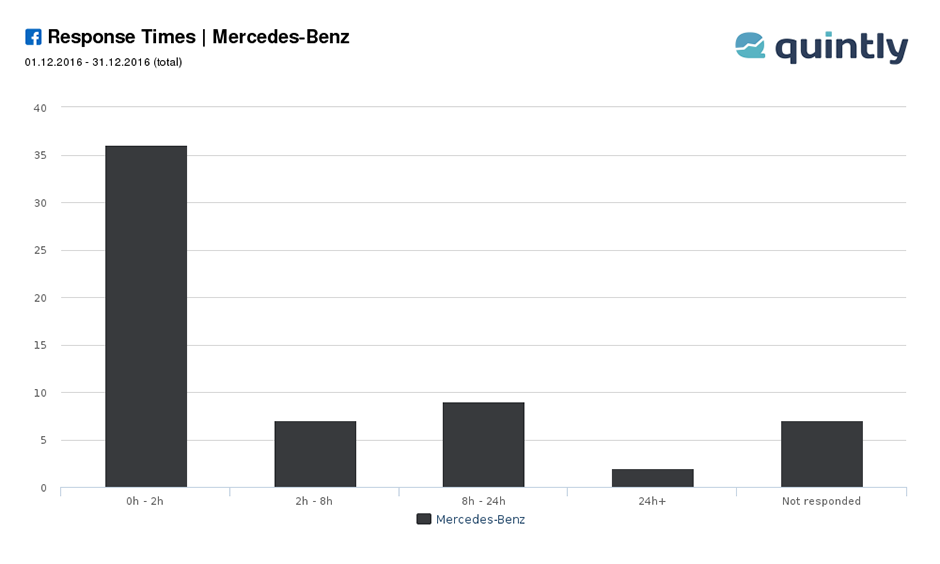
Retargeting
Retargeting in online advertising means that you take collected data of the behavior of internet users to show them more ads in another context. Imagine you run a web shop for watches but don’t sell anything. By collecting this data with a small pixel on your page and using it with a retargeting platform, it is now possible to identify the user again on another web sites and then display an ad there that promotes your web shop or even the specific product the user was looking at. By doing so, you can remind your potential customer again of your product, recapture his or hers interested, hopefully bring them back to your site and make them a customer.
Facebook also offers various options for retargeting. For example, it is possible to install a Facebook pixel on your web site and identify the users that are logged in with Facebook. This (anonymised) data later becomes available within the Facebook ads manager and it can be used for targeting these users in ads. It is also possible to upload email addresses that you might have collected with your newsletter.
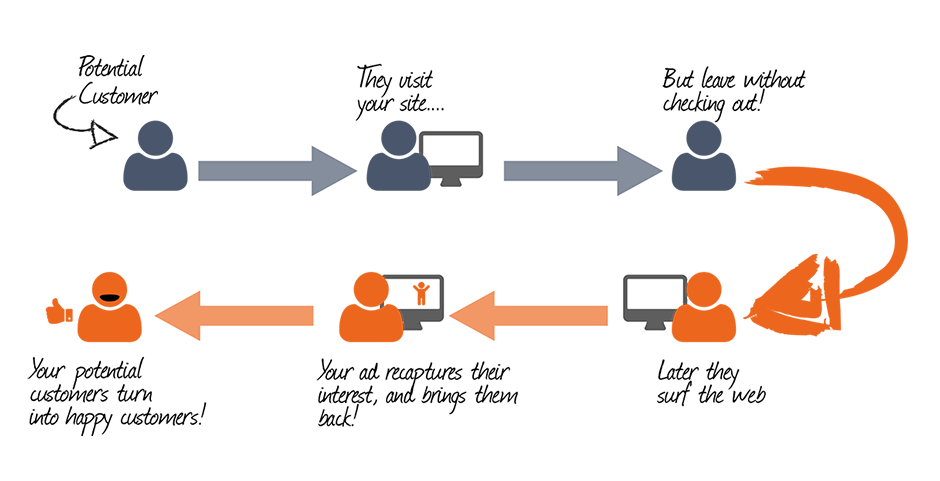
© https://retargeter.com/what-is-retargeting-and-how-does-it-work
ROI
Return on investment in social media can be any desired outcome from the time or financial resources that you have invested in social media activities. It is calculated by the following formula:
ROI = (return – investment) / investment
Especially in social media marketing, it can sometimes be hard to measure returns in dollar amounts. However, the ROI is best calculated in Dollars, Euros or whatever currency the operation of your business is based on. As there is no “amount of return” tag attached to the number of shares or likes you might get out of an investment, you need to assign values in a currency to them. To find more about how to best calculate your social media ROI, refer to this article by Kevan Lee, who has compiled a short but awesome guide on the topic.
Scale
Social media marketing and community management can consume lots of time and resources. However, you need to make some progress in order to build an audience and make social media a tool that can have a real impact on the success of your business. To increase your social media output, you can use automation or repurpose existing content. However, it is very important to never rely on these “tricks” too much. If you use the same content too often, your audience might just get bored and leave you. The same holds true for the design around it. If you rush it just for the sake of pushing out lots of content, your posts or blog articles won’t look appealing. So keep in mind that scaling can help you, but don’t overdo it!
SEO
If you want to know more about social media analytics solutions, it is very likely that you just type it into the web browser and you will end up on Google. As this is what most people do, search engines have become an important mean to get people to your page. However, if your entry does not appear on the first page of search results, it will be less likely that people get to your web site. Accordingly, you should invest some time into optimizing your ranking.
Search engines like Google employ crawlers to identify content on the web and index it. The allocation of a page rank follows certain rules that change every now and then. However, there are some aspects that are important for SEO. For example, the Google crawlers check the headlines of your blog articles. It is thus important that you define them in the right way when you set up content. There is many more factors that influence your page ranking. In order to have them all at hand and be able to adjust them in an easy way, it is helpful to use a SEO optimization plugins if you use Wordpress for example.
Sentiment analysis
Sentiment analysis tells you whether comments about you are positive, negative, or neutral. If you're busy, or are wading through huge numbers of comments, this can save a lot of time and effort.
Use negative sentiment to find complaints about your products, and reach out to people with issues. Or use positive sentiment to find people who like your brand, and thank them for their kind thoughts.
Sentiment analysis is a component of social media listening and complements social media analytics.
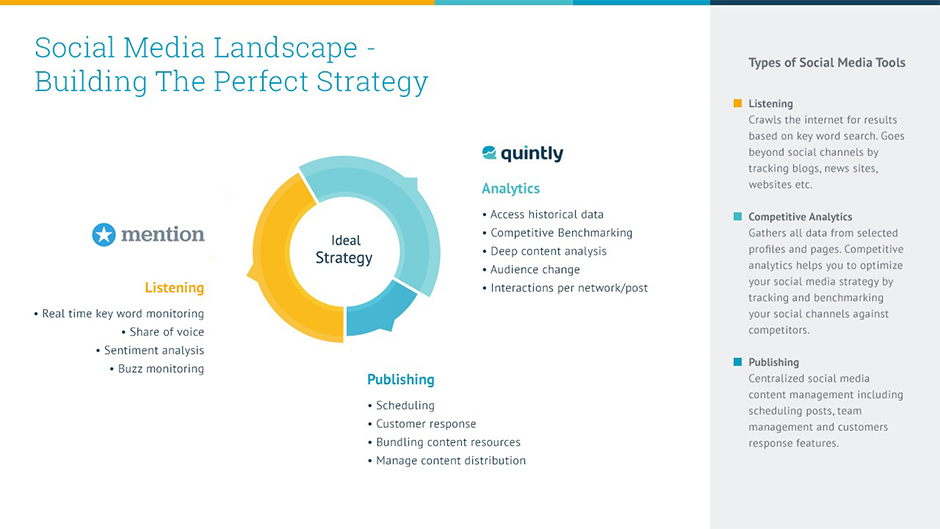
Social media analytics
Social media analytics is the process to process the data social networks provide in order to draw insights from them on which you can base your future social media activities. Social media analytics tools fetch quantitative data through the APIs of various social networks and help analyze them. By setting up specific KPIs, goal achievements can be measured. Besides the option to measure the performance of the social media channels you own, it is also possible to conduct benchmarks with your competitors. This can help you to get another perspective on the data from your social media profiles and put them in perspective. Have you used social media analytics before? Find out how you can benefit from social data analysis and book a demo with us now!
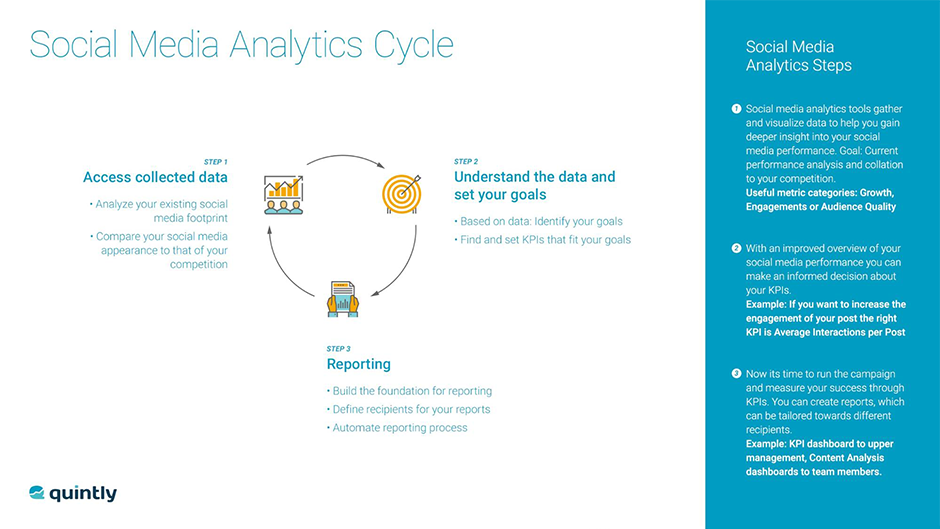
Social Media Scheduling
Social management platforms enable you to manage all your multiple social profiles at the same time from the same place. Schedule all your social media postings in advance. Great way to streamline your social media efforts.
Social selling
"Social selling today is influenced not only by digital markers, but customer influence online. In order to be successful brands need to both measure and engage with their community. One of the best ways to accomplish this is through live broadcasts — now available on both Instagram and Facebook."
Susan Gilbert: American author, publisher, entrepreneur and consultant
Sponsored posts
If you post something on a social network and then spend some money to boost it in order to reach more people or get more interactions, that post would become a sponsored (or paid) post. Easy, huh? However, there is a whole universe of ideas out there on how to do them right. There are questions like “What is the perfect type of targeting?”, “What content has the highest chance to get lots of clicks without paying too much?” or “Should I rather spend a lot on one day or smaller amounts over several days?”.
Webinar
A live stream or pre-recorded online seminar or presentation held by a company, team or an expert in his/her field to educate or to provide more information about a certain topic. Engage your audience by interacting them and providing an Q&A after your presentation.
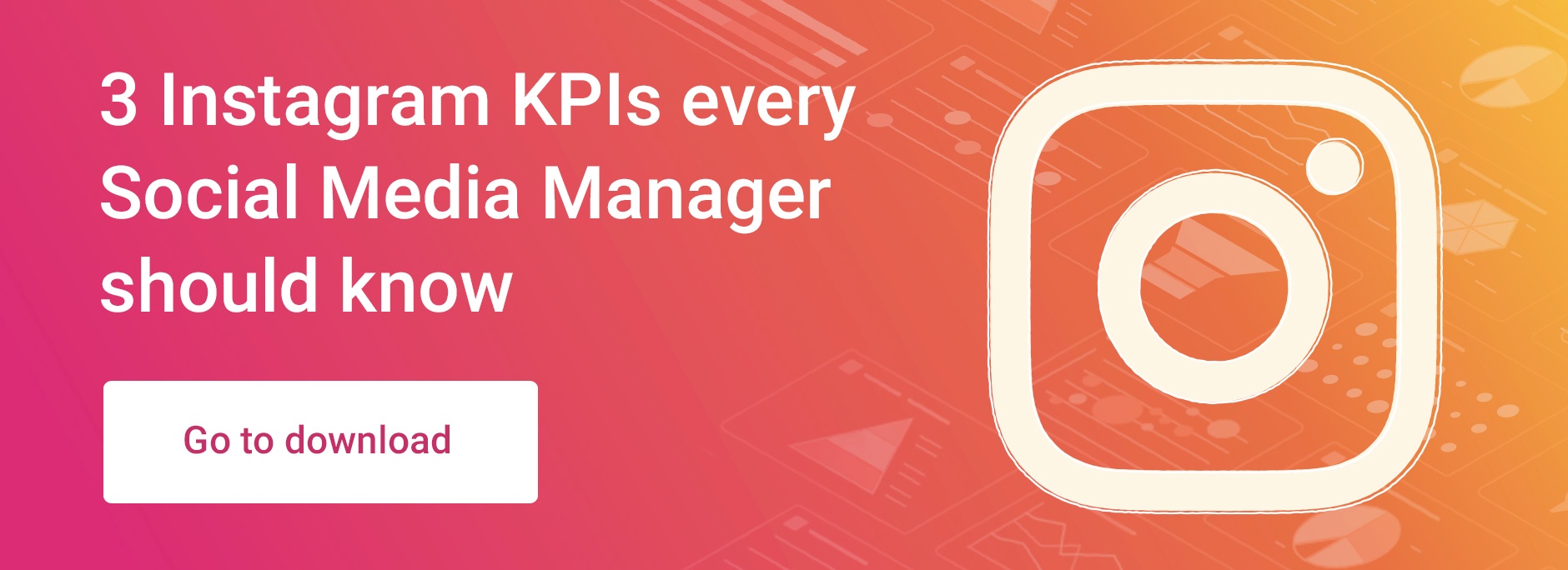
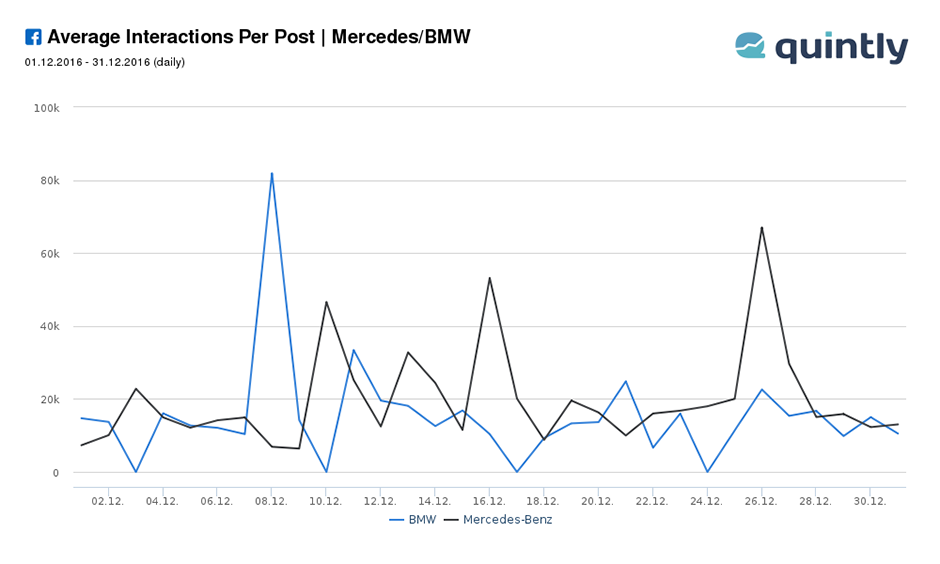
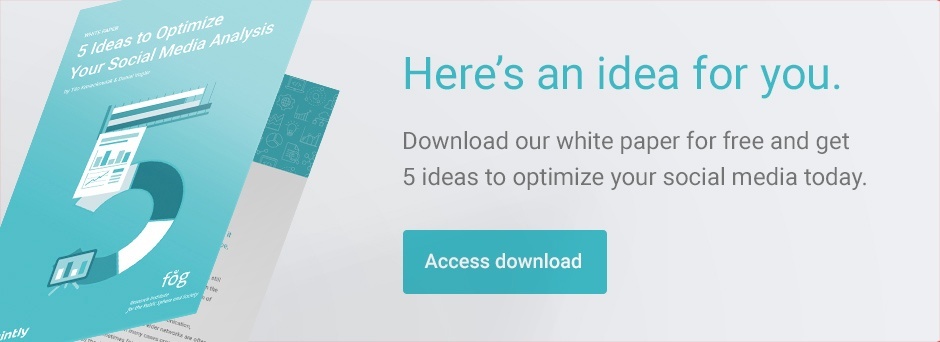
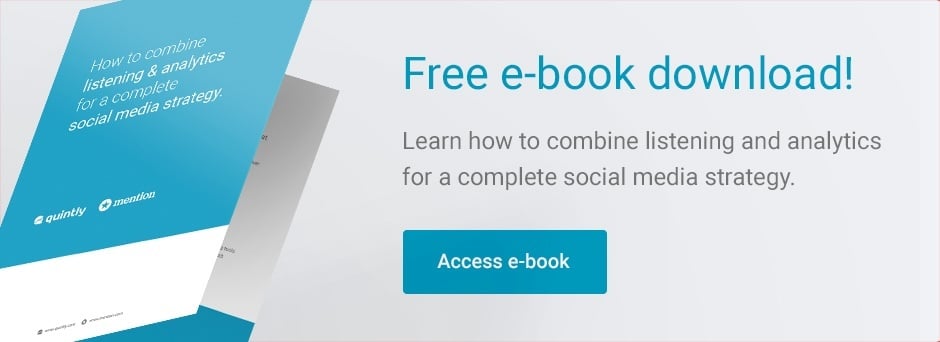
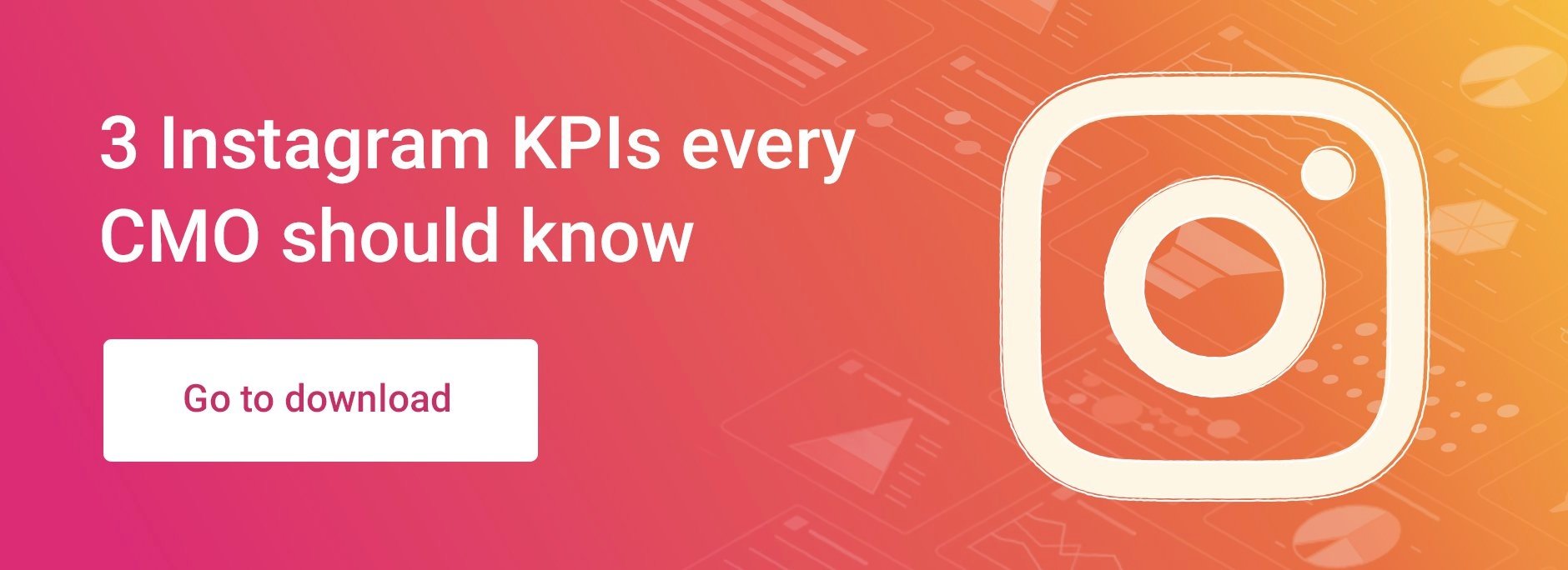

Join the conversation. Leave us a comment below!